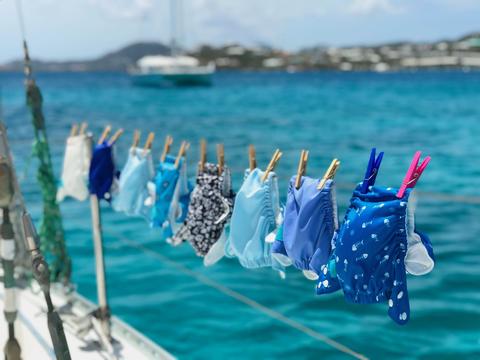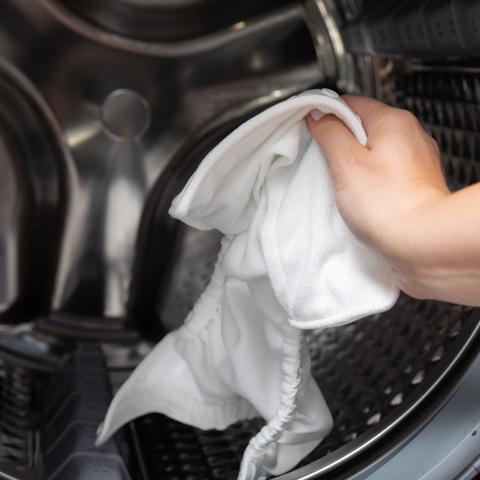How to Strip a Cloth Diaper?

Inside the blog:
What does stripping cloth diapers mean? How often to strip cloth diapers When to strip cloth diapers Instructions for stripping cloth diapers How about stripping cloth diapers with bleach? Instructions for stripping Charlie Banana cloth diapers How to maintain cloth diapers to avoid strippingEww… what’s that smell? If you’re wondering this after your baby’s cloth diapers have just been washed, then there’s a good chance you’re dealing with mineral buildup. Don’t worry, this doesn’t mean the cloth diapers are ruined. However, it probably means your cloth diapers need to be stripped. Have no fear, removing buildup by stripping cloth diapers is quite simple. There are several ways to deal with this issue. One way is by soaking the diapers. If you have issues with hard water, you can use RLR detergent, or a mixture of washing soda, borax, and Calgon. To soak diapers, you can either use a bathtub or a top load washer. You can also consider stripping cloth diapers with vinegar. Read on to discover all the recommended methods of how to strip cloth diapers and learn more about cloth stripping, why it’s needed, and how this method can help renew your baby’s diapers.
What does stripping cloth diapers mean?
The term “stripping” sounds much harsher than it really is. It does not mean bleaching, washing, or laundering with water only; these things can help with odors, but generally are not enough to remove the residues. Stripping cloth is simply a method to remove mineral or bacteria buildup to help diaper fabrics come out cleaner and more absorbent. Buildup often happens from washing your diapers regularly in untreated hard water. It can also happen from using too much detergent, fabric softeners or even from diaper cream. The laundry strip helps to get ammonia smell out of cloth diapers and improves their absorbency.
How often to strip cloth diapers
Stripping nappies or cloth diapers doesn’t need to be a part of your regular washing routine. In fact, it can take a toll on fabrics, so it’s something you don’t want to do too often. Stripping only needs to happen under certain circumstances. With a proper laundry routine, there’s a chance you’ll never have to strip diapers at all. If you find yourself needing to strip diapers regularly, take a look at your normal wash process. You may need to change detergents or methods, and you may need to test your water hardness. If hard water causes the problem, try adding a water softener (but not fabric softener) to the laundry.
When to strip cloth diapers
How do you know you need to strip your cloth diapers? Here are a few good signs:
The diapers retain a bad odor, even after they’ve been washed.
-
The diapers seem okay when clean, but then stink really bad as soon as your baby pees.
-
The diapers seem less absorbent even after you checked (and double checked) for a secure fit.
-
You’ve left the diapers to sit unwashed for more than a few days, and the smell coming from your diaper pail has reached a whole new level of stinky.
-
You regularly wash cloth diapers in untreated hard water. Hard water can lead to diaper buildup as the high mineral content can adhere to fabric.
-
You’ve just received secondhand cloth diapers. Unless you know for a fact the diapers have just been stripped, we recommend stripping used cloth diapers to remove any detergent, mineral or urine residues that may have been left behind
Instructions for stripping cloth diapers
The process is really quite easy and only takes a few laundry stripping ingredients. To begin, make sure you start with clean diapers. For stripping modern cloth nappies, like fitted, pockets or AI2 diapers, you only need to strip the absorbent parts. If the diapers are flats, pre-folds or AIO diapers, you can strip the entire thing.
-
Fill your tub or top-loading washing machine with hot water until the diapers are covered.
-
Add a laundry stripping solution to the water. There are a few options when it comes to this. Below we’ve listed a few methods that we know a lot of cloth diapering parents consider.
-
Keep the diapers in the container for about 4-6 hours. It’s also ok to leave them overnight.
-
Wash on the longest cycle available. Use the highest water temperature allowed by your cloth diaper manufacturer. (Note that washing at high temperatures exceeding the manufacturer’s recommendations might damage the diapers’ waterproof outer layer.)
Dry the diapers as usual.
Option 1: RLR cloth diapers strip
Another popular method is an RLR soak for cloth diapers. To do this, add a packet of RLR detergent to hot water. One packet works for about 30 diapers, so you may need to adjust the amount depending on how many diapers you’re stripping.
Option 2: Strip cloth diapers with vinegar
Stripping cloth diapers with vinegar is not a myth. White vinegar is a great solution for cloth diaper laundry and is beneficial in a number of ways. When used in the rinse cycle, it removes detergent buildup and hard-water minerals, and neutralizes the ammonia from urine.
You can add 1/2 or 1 cup of white vinegar to one of the rinse cycles to remove the possible detergent residue and to soften your cloth diapers. You can add this via the detergent drawer or toss it directly in on top of the diapers.
Option 3: Strip cloth diapers with Dawn dish soap
Many parents have found that stripping cloth diapers with Dawn dish soap is a gentle and effective way to remove residue and buildup from the fabric. To do this, just add one tablespoon of the original blue liquid Dawn dish soap to your tub or top-loader.
Option 4: DIY cloth diaper strip recipe
Some parents make their own stripping solution. To do this, mix together 3 tablespoons each of washing soda, Borax and Calgon.
-
Add diapers to your solution and stir or agitate the water. You might want to take an extra step of using a scrub brush and gently scrub the absorbent parts of the diaper to make sure the stripping solution really gets into the fabric.
Soak diapers overnight or for at least 6 hours.
-
Follow the strip by rinsing diapers thoroughly by hand or by running 2-3 rinse cycles in your washer until there aren’t any signs of soap or detergent left.
-
Air dry the diapers in the sun. The sun acts as a natural disinfectant to remove bacteria and will help give the diapers a clean, fresh scent.
How about stripping cloth diapers with bleach?
For Charlie Banana cloth diapers, we only recommend using non-chlorine bleach as needed, as chlorinated bleach might damage the colors on your diapers and also increase the fabrics’ wear-and-tear.
Bleaching diapers is sometimes recommended for non-colored flats and pre-folds. However, be sure to read the manufacturer’s instructions, because bleaching is not recommended for most modern cloth diapers.
Instructions for stripping Charlie Banana cloth diapers
Many of the stripping methods mentioned above can be used on Charlie Banana cloth diapers. If you do strip the pocket shells, avoid using hot water as it can damage the waterproof outer layer. We also do not recommend using chlorine bleach on our diapers. If slight staining occurs, hang your diapers outside to dry naturally. Not only will you conserve energy, but your diapers will also benefit from the natural sun bleach. For more specifics on how to care for your Charlie Banana, check out these care instructions.
How to maintain cloth diapers to avoid stripping
Want to avoid having to strip your diapers in the future? The best way to maintain cloth diapers is to immediately rinse them after they become soiled or keep them in a water pail before laundering. The faster you wash the diapers the better.
Avoid using fabric softener or detergents with fabric softener, as they can cause mineral buildup, which will decrease the absorbency of your cloth diapers.
To prevent future ammonia smells, you can also wash with white vinegar or baking soda. To do this, just pour 1 cup of vinegar into a wet diaper pail and pre-soak the diapers, or just pour it straight into the washing machine’s detergent drawer before starting the wash. Alternatively, you can add a couple of tablespoons of baking soda to the laundry.
Treating hard water is also key to avoid diaper stripping. To do this, be sure to add water softener to your cycle every time you run a load.
Figuring out a good cloth diaper washing routine might take time, and mistakesmight happen. Using fabric softeners and/or untreated hard water for laundering cloth diapers can decrease their absorbency, but don’t worry, very rarely will it completely ruin the diapers for good. Thankfully, stripping cloth diapers helps eliminate all the icky buildup, so that the diapers, once again, become as good as new.
